Thursday, Nov. 1
- Southwestern chicken tortilla
- Philly style cheese steak
- *Garlic herb roasted pork
- Mediterranean chicken packages
- Southwestern turkey wrap
- Assorted slice pizza
- *Marinated grilled chicken caesar salads
*Carb restricted alternative
Wilson Hall Cafe menu |
|
Thursday, Nov. 1
Dinner
- French onion soup
- Grilled halibut w/tarragon white butter sauce
- Grilled new potatoes
- Green beans w/lemon zest
- Chocolate soufflé
w/hazelnut crème Anglais
Wednesday, Nov. 7
Lunch
- Chipotle chicken w/corn cakes
- Latin confetti salad
- Rum pecan cake
Chez Leon menu
Call x4598 to make your reservation. |
|
|
|
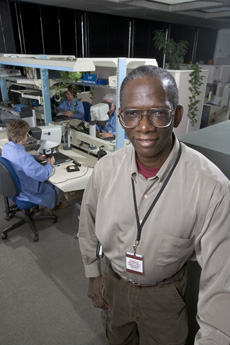
Curtis R. Danner - Technical Specialist in PPD, Electrical Engineering Department
"I take a preemptive approach to safety by 'thinking safety' 24/7, rather than 9 to 5. This forces me to analyze my daily tasks at home, at work or at play."
See all Fermilab Profiles in Safety here.
|
TD honors safety record, achievements with fall picnic
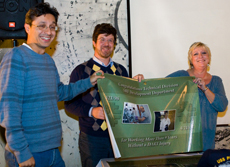
Technical Division Head Giorgio Apollinari presents a banner commending the SRF Development Department safety record to Tug Arkan and Donna Hicks. Apollinari presented several banners to TD departments and sections honoring their safety records at the annual division picnic in Kuhn Barn Oct. 25.
The Technical Division takes safety seriously, even at its annual picnic. The division waited until Oct. 25 to celebrate another year without an injury that kept employees off the job, avoiding wasps, bees and other insects that invaded the picnic last year. The date change prevented conflicts with the busy accelerator shutdown period and allowed both former and current division heads to attend, according to Design and Drafting and Computer Information Systems Department Head Bob Andree. About 200 people attended.
As employees munched on fried chicken, steak sandwiches and potato salad, Giorgio Apollinari, the new head of the division, announced this year's safety record and accomplishments. All TD departments have worked at least four years without a DART* injury. The Materials Control Department has the best record of the TD departments, having gone 11 years without any DART injuries.
The TD maintained safety while taking on new work loads. TD developed a new vertical cavity test system, made breakthroughs in high-field magnet technology and supported the Accelerator Division this year, Apollinari noted.
Romesh Sood, associate head of the division, said the picnic was an important opportunity to recognize achievements. "The picnic was a morale-boosting celebration of safety and accomplishments," he said.
* DART stands for Days Away, Restricted, Transferred
-- Haley Bridger
|
Grids work like a CHARMM for molecular dynamics
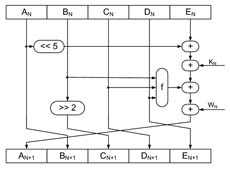
X-ray crystallography at room temperature revealed only one water molecule (shown as a red sphere) near the protein residue of interest (shown in the box). The protein is a variant of staphylococcal nuclease.
Images courtesy of Johns Hopkins University
In 1963, Richard Feynman said that "everything that living things do can be understood in terms of the jiggling and wiggling of atoms." (1)
Molecular dynamics aims to better understand these jiggles and wiggles, using numerical methods to simulate the ways in which atoms and molecules move.
One tool facilitating this work is CHARMM-or Chemistry at HARvard Macromolecular Mechanics-a software application developed at Harvard University for modeling the structure and behavior of molecular systems.
CHARMM has multiple applications, but for Ana Damjanovic of the National Institutes of Health and Johns Hopkins University in Baltimore, Maryland, U.S., molecular dynamics simulations are the name of the game.
Read More
-- Jen Nahn, Open Science Grid
|
US astronomers spot massive, record-setting stellar-mass black hole
From AFP, Oct. 31, 2007
US astronomers have discovered the biggest black hole orbiting a star 1.8 million light-years from Earth in the constellation Cassiopeia, with a record-setting mass of 24 to 33 times that of our Sun, NASA said Tuesday.
The massive newcomer beats the previous stellar-mass black hole discovered October 17 in the M33 galaxy that has 16 times the mass of our Sun, the US space agency said.
Like the much larger, supermassive black holes found at galaxy centers, stellar-mass black holes have such powerful gravity fields that not even light can escape them. Astronomers estimate their mass by measuring their gas emissions and the gravitational effect on the stars they orbit.
"We weren't expecting to find a stellar-mass black hole this massive," says Andrea Prestwich of the Harvard-Smithsonian Center for Astrophysics in Cambridge, Massachusetts.
Read More
|
|
|
Reuniting a family
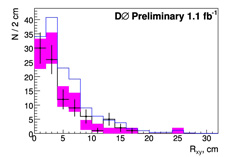
This figure shows the transverse displacement of the reconstructed vertices of Z boson decays to two electrons in the DZero detector compared to the prediction of the Standard Model (black points and purple shaded boxes respectively). An excess of events with large displacements over the prediction, like the one shown with a blue line, would indicate the production of long-lived Z boson parents.
The Standard Model of particle physics contains many families, for example the three families of fermions or the brotherhood of electroweak bosons. But one member of this electroweak brotherhood, the Z boson, may have a past unknown to the Standard Model or those who study it: long-lost parents. The challenge of reuniting a family is large, but members of the DZero collaboration at the Tevatron are trying hard to help the Z boson. Like most searches for parents, the success of this effort is more likely if the parents have long lifetimes.
Finding a missing parent can shed light on the mysteries of a person's identity and history. DZero researchers hope their search for long-lived parents of the Z boson will do the same, as a discovery could clarify many mysteries of the Standard Model. These parents could come from a variety of backgrounds, such as a fourth generation of quarks or gauge-mediated supersymmetry, and each one would tell us something different about our universe. Such a long-lived particle would travel several tens of centimeters after being produced, which would make it easier to find than short-lived particles. Upon decaying to a Z boson, evidence for the parents would come from the Z boson itself decaying promptly to two leptons. The dilepton vertex displaced far from the detector's center would mark where the Z boson's parent decayed.
Unfortunately for the DZero researchers, this means the vertex would likely fall outside of their tracking detectors' reaches. With a little ingenuity, they were able to use the electromagnetic calorimeter and central preshower portions of the DZero detector to reconstruct Z→ e+ e- vertices. By searching for an excess of such decays far from the detector's center, the DZero physicists were able to help the Z boson search for its parents.
In 1.1 inverse femtobarns of integrated luminosity, DZero researchers found no evidence for displaced Z boson production. This null result allows them to set the world's tightest limits on models that generate a long-lived parent of the Z boson. But the search is not being abandoned, as a reunion of the Z and its parents would teach us much about our universe. As the Tevatron continues to deliver luminosity, DZero scientists will be carefully trying to bring this family together.
| Yuri Gershtein (foreground) and Yurii Maravin made primary contributions to the search for long-lived Z boson parents.
|
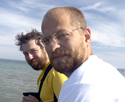 |
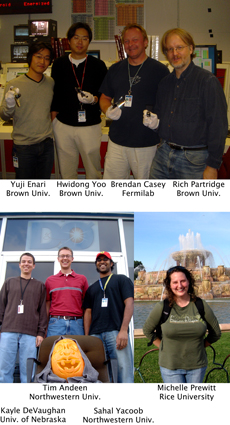
The DZero luminosity group are responsible for both the hardware and online software that measure the luminosity delivered by the Tevatron. Their hard work is essential for all DZero analyses. Luminosity is one of a few numbers quoted in every DZero paper and though it is essential to all analyses, it is critical to many, such as the one presented here.
Result of the Week Archive
|
|
Have a safe day!
Lost item
Pleas help to locate a gold pin shaped like a ribbon that contains red and white stones. The pin has high sentimental value, and a $100 reward will be given if the item is found. The pin was last seen during a tour of TD, CDF and Wilson Hall, and may be at or between those areas. If found, please contact Leonardo Ristori in the Technical Division, leoristo@fnal.gov or x4401.
Praire Harvest on Nov. 3
The second 2007 Prairie Harvest is being held on Nov. 3, 2007, from 10 a.m. to 2 p.m. More information on the event can be found here. Plan to learn more about our ecology and the prairies.
International Folk Dance Halloween and Dia de los Muertos party tonight
International Folk Dancing will hold a Halloween and Dia de los Muertos Party tonight, Nov. 1, at Kuhn Barn. Costumes and treats are encouraged. Dancing begins at 7:30 p.m. with Mexican dances and special Halloween fun. Newcomers are welcome, and you do not need to come with a partner. For more information, call (630) 584-0825 or (630) 840-8194 or e-mail.
EAP office hours temporary change
The EAP office will be closed Friday, Nov. 2. It will be open again on Tuesday, Nov. 6, from 9 a.m. to 1 p.m. but will be closed Wednesday, Nov. 7, and Friday, Nov. 9. The EAP office will resume the regular schedule on Wednesday, Nov. 14. The EAP is available 24/7 by calling (800) 843-1327.
Flu shot clinic Nov. 6
The Fermilab Medical Office will be offering a flu shot clinic on Tuesday, Nov. 6, 2007.
If you have received the flu shot, please ignore this notice. You are eligible to receive the flu vaccine free if you are an active, full-time, regular employee or a term or temporary employee.
Contractors, family members of employees, visitors, experimenters, seasonal employees, dayworkers, on-call workers or retirees are not eligible. The clinic will be held in the ES&H Training Room on the ground floor of Wilson Hall from 9 a.m. to 12:30 p.m. Advance registration is required and is available online or by calling x3232.
Additional Activities |
|